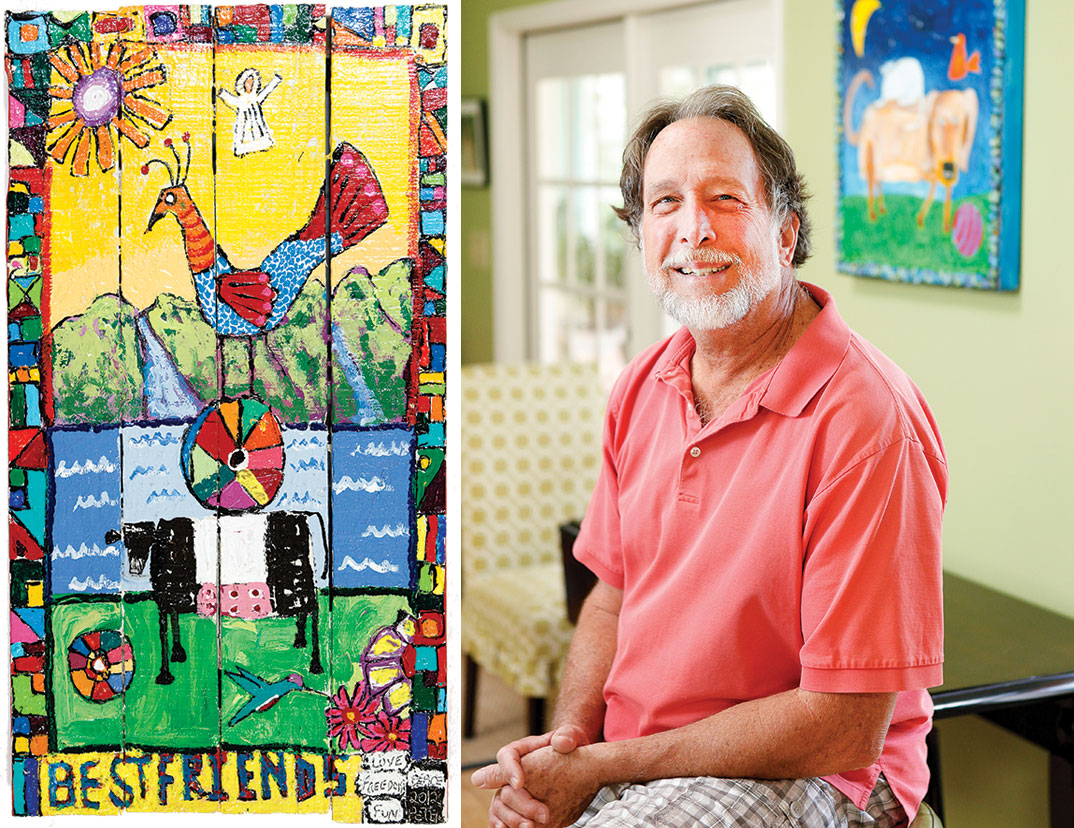
“There is so much color to be used … I’ve never wanted to give my work a particular scheme,” says un-folk artist Peter Chumbley. Portrait by Matt Rose.
Casual collectors and connoisseurs alike are quick to call Peter Chumbley’s work “folk art,” and he doesn’t argue with them. But he certainly doesn’t affix the label to it himself.
“Then I might start thinking, ‘Well, I have to paint folk art rather than just paint,’” he quips, adding, “The hardest thing about painting to me is to not think. I try to keep my mind out of it and just paint with my heart.”
The Brevard-based artist says he’s most successful when he feels completely free as he’s painting, unencumbered by thoughts trying to steer him in a “traditional” direction. To that end, his work does share something in common with the folk movement: fine-art rules need not apply.
“I always tell people that God blessed me with a total lack of talent,” he says, although not disparagingly. “I don’t consider myself to be technically talented or skillful, but I look at that as a real strength: I have a certain desire and compassion that pushes me to paint. You come up with some different paintings when you paint like that.”
In fact, sometimes what he paints is downright — his own word — strange. Namely, a mysterious round object that can be found in nearly all of his pieces. “Some people think it’s a palette or a wheel. But I don’t know what it is.” The shape seems to have a mind of its own, and that’s fine by him. “At times I’ve looked back to paintings that I did 25 years ago, and sure enough there’s something like that hanging around. I like it, so I’ll keep sticking it in there.”
And, he says, he’ll stick with the way he paints the mysterious circle and other components of his work: colorfully — inspired in part by 30 years spent soaking in the bright, bold culture of Miami. “There is so much color to be used, and to try to give into a particular scheme of some sort, I’ve just never wanted that to happen,” he notes. “It’s pretty free: I apply the paint freely, and I select the colors just as freely.”

A mysterious round object appears in nearly all of his Peter Chumbley’s pieces. “Some people think it’s a palette or a wheel. But I don’t know what it is,” he says.
While teaching art in Greensboro’s public-school system — he spent 25 years in the classroom and is now retired and focused on painting daily — Chumbley got some pushback from parents, and even some students, over his go-with-the-flow approach. They wanted him to teach the “fancy techniques,” but he held fast to his philosophy.
“I gave them some materials and a wide-open question to be solved with their art and let them go from there.” He stresses, “You don’t really teach art. You provide the opportunity to create art.”
A number of his students are now art teachers themselves, which gives him a great sense of satisfaction. After all, it was an art teacher who solidified his own path as both an educator and a painter: although he already had a college degree, he enrolled in an art-education program after traveling Europe and finding inspiration in the art and architecture he saw.
“I wasn’t sure the direction I was going to go with it, but oddly enough, when I did my teaching internship, I ended up working under my elementary-school art teacher,” he shares. “She made a big impression on me, and then to find myself with her — this incredible person and incredible teacher — it sealed it there. It was what I should be doing.”
As he was with his career choice and teaching style for two decades, he is now unwavering in his purpose for painting: to spread hope and happiness.
“I feel more than ever that we’re a little low on happy in this world, so I try to throw in my share of it and see what can happen.”
He works to evoke the feeling not only by choosing color with abandon, but also by being purposeful with his subject matter. Chumbley primarily paints animals, from cats to cows, or children playing and having fun. He also often sneaks in spiritual emblems to protect his subjects. He paints all of his pieces on handmade wooden supports that, like the paintings themselves, aren’t overly precise.
It’s not difficult for him to tap into the carefree spirit of a child: He sees himself as a big kid who’s never grown up. And he looks at his success with wide-eyed amazement. “It’s always exciting to know that somebody would like your painting in their home,” he marvels.
His work was accepted into Number 7 Arts in Brevard shortly after he relocated to WNC three years ago, and he was recently invited into Seven Sisters Fine Arts and Crafts Gallery in Black Mountain.
“This wasn’t intended to be a job; it’s just something I really enjoy doing, and fortunately some people enjoy looking at it. Right now it’s working, and we’ll just see where it goes … that’s about the size of it.”
See Peter Chumbley’s work, visit Number7arts.com. Peterchumbley.com.
